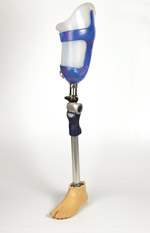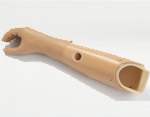Transtibial Prosthesis
A transtibial prosthesis is an artificial limb that replaces a leg missing below the knee. Transtibial amputees are usually able to regain normal movement more readily than someone with a transfemoral amputation, due in large part to retaining the knee, which allows for easier movement. Lower extremity prosthetics describe artificially replaced limbs located at the hip level or lower.
In the prosthetic industry, a transtibial prosthetic leg is often referred to as a “BK” or below-the-knee prosthesis while the transfemoral prosthetic leg is often referred to as an “AK” or above-the-knee prosthesis.
Other, less prevalent lower extremity cases include the following: Hip disarticulations – This usually refers to when an amputee or congenitally challenged patient has either an amputation or anomaly at or in close proximity to the hip joint. Knee disarticulations – This usually refers to an amputation through the knee disarticulating the femur from the tibia.
The majority of prosthetic devices are for below-the-knee amputees an intimate socket fit will provide improved comfort and gait patterns. Prosthetic devices commonly use silicone, urethane, or elastomeric gels to fit direct to the residual limb and hold the prosthetic device with or without pin locks. Elevated vacuum socket use is also on the rise and the intimate fit provides better blood flow to the residue limb for greater limb health for the amputee.








